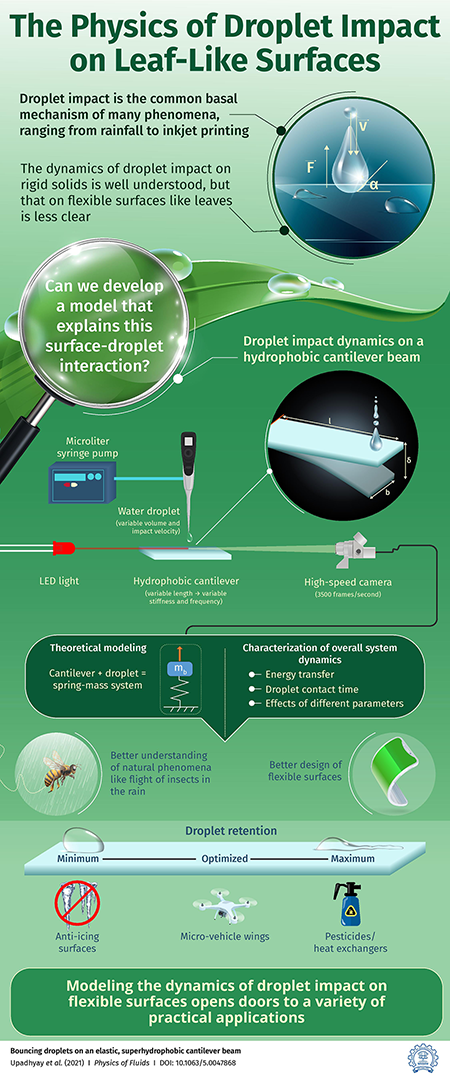| Sep 16, 2021 |
Why do raindrops bounce of leaves?
(Nanowerk News) The interaction between a liquid drop and a rigid surface it falls on is well explored, but what changes when the surface isn’t so flexible, like in the case of a leaf?
|
|
Scientists from the Indian Institute of Technology Bombay (IIT Bombay), India, used a camera to capture visuals of a water droplet falling on an artificial leaf-like structure in slow motion. Their observations offer us a peek into a range of applications for this discovery from designing better pesticide sprays to developing ideal anti-icing surfaces.
|
|
Every motion around us, from the spill of coffee on your table to raindrops falling on leaves, follows certain rules of physics. The mechanisms of liquid drops falling on a rigid surface, like the coffee spill, are easy to study; one of the two participants in this interaction (the table) doesn’t really change. But what about the interaction between two “moving” participants, such as in the case of a falling drop and a flexible leaf?
|
|
“When a droplet hits a flexible surface like a leaf, energy is transferred from the droplet to the surface, causing it to vibrate,” explains Prof. Rajneesh Bhardwaj from Indian Institute of Technology Bombay, India. “Sometimes the droplet bounces off the surface almost immediately after impact; sometimes it stays stuck. To date, no study offers a complete understanding of the dynamics of this situation.”
|
|
Knowing the mechanics of this interaction is fascinating for a curious physicist, but it changes so much more: from developing efficient pesticide sprays (another type of droplet that falls on leaves) and rainwater harvesters, to designing better micro air vehicles.
|
|
In their latest study ("Bouncing droplets on an elastic, superhydrophobic cantilever beam"), which was selected as Editor’s Pick in Physics of Fluids, Prof. Bhardwaj and his team conducted a series of experiments, in which they used a high-speed camera to observe the interaction of water droplets falling on flexible “cantilever” beams, which are artificial structures which are supported at one end, carry the weight at the other end, and designed to be water-repelling, resembling a leaf in every way possible.
|
 |
| (click on image to enlarge)
|
|
The images acquired by the team revealed in detail how the spherical water droplet changes its shape as it hits the cantilever, the exact motions of the cantilever oscillating in response, and how long it takes the droplet to bounce off the cantilever.
|
|
“We primarily tried to understand the conditions that dictate the droplet’s bouncing mechanisms,” explains Dr. Bhardwaj. “The whole event happens at a microscopic time scale, so we performed high-speed imaging at 3500 frames per second; roughly recording one image per 0.3 milliseconds.”
|
|
Based on the gathered data, the team figured out the surface-droplet system’s dynamics, and even predicted how to bring about different outcomes by modifying parameters. For instance, maximizing duration in which the droplet remains touching the cantilever is useful when designing more efficient pesticides. On the other hand, minimizing the contact time is desirable for anti-icing surfaces. Maximizing the energy transfer from the droplet to the surface is ideal for rain-based energy harvesting systems.
|
|
“Our study provides a solid understanding of a natural phenomenon that is relevant to modern human technology. With the new insights, we could not only better understand how insects fly in rainfall, but also improve upon future designs for micro air vehicle wings,” says Prof. Bhardwaj.
|

